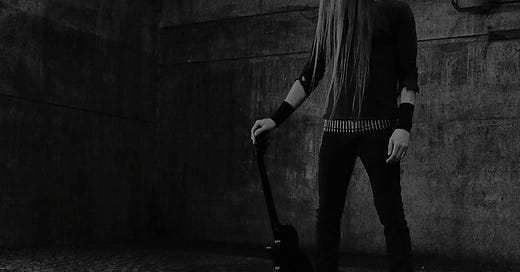I don’t know how long I’ve been a fan of one-man Danish black metal act Nortt, but he’s been at it for 30 years; his Encyclopaedia Metallum page says he started the project in 1995. He’s managed to maintain total anonymity, never playing live and only granting email interviews. (I sent him some questions in 2017, when his last album, Endeligt, was released.)
He released three albums — Gudsforladt (“Godforsaken”), Ligfærd, (“Funeral”) and Galgenfrist (“Gallows temptation”) — between 2003 and 2007, then took a decade off before returning with Endeligt (“Finally”). Now he’s back again; Dødssang (“Death Song”) will be released next week.
Dødssang is superficially similar to all of Nortt’s previous work. The eight compositions are achingly slow, and most run between six and eight minutes. The longest, “Bøn til døden” (“Prayer to death”), is a little under nine, and there are two-minute intro and outro tracks. The instrumentation is spare and simple: distorted guitar and bass chords that decay like those of Sunn O))), underpinned by minimal drumming almost reminiscent of early Swans, and right in the middle of it all, mournful grand piano and hoarse, croaking, nearly indecipherable vocals.
I don’t generally have much use for black metal. It seems to have the most overt Nazi content of any metal genre, and even when it doesn’t, the music can feel underpowered and overwrought to the point of silliness. But Nortt’s music doesn’t have much in common with other black metal. Distorted, nerve-scraping guitars? Check. Raspy, goblin-like vocals? Check. But there are no blast beats — everything crawls along — and the emphasis on piano makes it desolate and haunted, leaning toward existential dread rather than rote blasphemy or misanthropy. This stuff hypnotizes me, drawing me in more than almost any other metal around right now. And he takes so long between albums that they arrive as a welcome (I almost said “pleasant”) surprise.
Nortt works hard to sustain a single mood throughout Dødssang, though there are subtle differences between tracks. “Ensomhed” (“Loneliness”) lays on top of what sounds like a field recording of a dripping underground cave, and there’s a synthesizer moaning romantically, like Nortt’s being haunted by the ghost of Klaus Schulze. On “Dødssang” and “Alt er tomhed” (“Everything is emptiness”), he slows and pitches his voice down to a subterranean growl. The result is like a black metal version of Slotek, the mysterious instrumental hip-hop project whose 1997 debut album 7 blended occult knowledge with deep, dark beats. The album’s outro, “Udslukt” (“Extinguished”), is simply the church bells from Black Sabbath’s debut album with a dark synth drone underneath.
Music like this serves a specific purpose in the listener’s life. You’ve got to be willing to put on headphones and possibly close your eyes and let it push you gently out into a slowly flowing river… to Hell, ha ha ha! Seriously, though, this is music that requires focused listening, because when you’re really paying attention you’ll notice the small, creative touches, like how the tape hiss on “Til Gravens Vi” (“To the grave we”) from Galgenfrist ends a few seconds before the track does; the ambient synth drone keeps going without it. Tape hiss as an actual compositional element. I know there were (and probably still are) tons of lo-fi indie auteurs who claim that’s what they’re doing, but they’re bullshitting. Nortt is not.
Like I said, black metal is mostly Not For Me. But when it pushes farther in the direction of art music, I get interested. For example, Marduk used to be really boring, but then they got a new singer — Daniel “Mortuus” Rostén — on 2004’s Plague Angel, and all of a sudden their music was much weirder and scarier. Rostén’s solo project, Funeral Mist, is even better than Marduk. Salvation and Maranatha are deeply unsettling records, in the best way.
Nortt has less in common with even arty black metal than with the work of Sunn O))). In fact, “Over mit lig” (“Over my body”), another track from Galgenfrist, on which dark ambient drones are crushed into the earth by concussive bass drum hits and endlessly resonating guitar chords, feels like a collaboration between Justin Broadrick (of Godflesh) and organist/composer Kali Malone (who’s married to Stephen O’Malley of Sunn O))), doncha know…).
Dødssang is less ambient and more morose than previous Nortt records, but it’s recognizably him. Any one of his albums can be a gateway to the rest of his catalog, so pick up the new one, lie back in the dark and let it overtake you, and then begin the journey backward.
And now, before I go, here’s something else, pretty much the polar opposite of Nortt in every way but just as awesome: Earth, Wind & Fire live in Oakland in 1981:
That’s it for now. See you on Friday, when I will attempt to sell you some newly reissued early albums by saxophonist Ivo Perelman, and will share some fascinating articles with paying subscribers.





Fascinating. The two Endeligt tracks linked to your January 2018 interview are nothing like I expected, which of course drew me in deeper, much more introspective and ambient, that reminded me of Coil's How To Destroy Angels... a little.